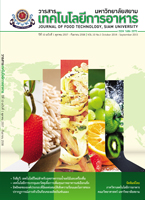การคัดแยกแบคทีเรียชอบเค็มที่ผลิตเอนไซม์โปรติเอสจากปลาร้า
Main Article Content
Abstract
งานวิจัยนี้มีจุดมุ่งหมายที่จะคัดแยกแบคทีเรียชอบเค็มที่สามารถผลิตเอนไซม์โปรติเอส จากตัวอย่าง ปลาร้า 6 แหล่ง จากการทดลองพบว่าสามารถแยกเชื้อได้ 12 ไอโซเลต ได้แก่ SA1, SA2, SA3, SB1, SC1, SC2, SD1, SE1, SE2, SF1, SF2 และ SF3 พบว่ามี 9 ไอโซเลต ได้แก่ SA2, SA3, SB1, SC1, SC2, SD1, SE1, SF1 และ SF3 มีลักษณะโคโลนี กลมนูน ขอบเรียบ ผิวมันวาวทั้งหมด ส่วนที่เหลืออีก 3 ไอโซเลต ได้แก่ SA1, SE2 และ SF2 มีลักษณะโคโลนีกลม แบน ขอบหยักเป็นคลื่น ผิวด้าน พบว่าแบคทีเรียทุกไอโซเลตมีการติดสีแกรมบวก 9 ไอโซเลต มีรูปร่างกลม และ 3 ไอโซเลต มีรูปร่างท่อน จากนั้นศึกษาความสามารถในการผลิตโปรติเอสของทั้ง 12 ไอโซเลต พบว่าแบคทีเรียที่สามารถผลิตโปรติเอสได้สูงสุด คือ SA1, SA2, SC2, SE2 และ SF3 (0.16 ± 0.03, 0.16 ± 0.07, 0.20 ± 0.04, 0.22 ± 0.03 และ 0.19 ± 0.01 ยูนิต/มิลลิลิตร) โดยไม่มีความแตกต่างกันอย่างมีนัยสาคัญ เมื่อศึกษาความสามารถในการเจริญของแบคทีเรีย 12 ไอโซเลต ในอาหาร production medium ที่มีความเข้มข้นของเกลือโซเดียมคลอไรด์ ร้อยละ 0, 5, 10, 15 และ 20 โดยน้ำหนักต่อปริมาตร เลี้ยงแบคทีเรียที่ 37 องศาเซลเซียส เป็นเวลา 24 ชั่วโมง จากการทดลองพบว่าไอโซเลต SA1, SA3, SC1, SC2, SD1, SE1, SE2, SF1, SF2 และ SF3 เจริญได้สูงสุดในอาหารที่มีความเข้มข้นเกลือ ร้อยละ 15 (อยู่ในช่วง 7.32-9.96 log CFU/ml) ส่วน SA2 เจริญได้ดีที่สุดในอาหารที่มีความเข้มข้นของเกลือ ร้อยละ 5 (7.85 log CFU/ml) และ SB1 เจริญได้ดีสุดในอาหารที่มีความเข้มข้นของเกลือ ร้อยละ 20 (9.05 log CFU/ml)
Screening of Protease Producing Halophilic Bacteria from Fermented Fish (Pla-ra)
This research aims to isolate protease producing halophilic bacteria from Pla-ra that obtained from 6 different areas. The 12 isolates namely SA1, SA2, SA3, SB1, SC1, SC2, SD1, SE1, SE2, SF1, SF2 and SF3 were selected and studied. The colonies of 9 isolates (SA2, SA3, SB1, SC1, SC2, SD1, SE1, SF1 and SF3) had a circular shape, convex, entire edges and glistening. The other colonies of 3 isolates (SA1, SE2 and SF2) had a circular shape, flat, undulate and rough surface. All isolates were Gram-positive. The 9 isolates were cocci shape and the 3 isolates were rod shape. Determination of protease activities from 12 isolates was performed. The highest protease activities were from SA1 SA2 SC2 SE2 and SF3 (0.16 ± 0.03, 0.16 ± 0.07, 0.20 ± 0.04, 0.22 ± 0.03 and 0.19 ± 0.01 units/ml, respectively) with no significant difference. After that, the growth and the protease activities of all isolates were investigated by culturing in the production medium with various concentration of sodium chloride of 0, 5, 10, 15 and 20% (w/v) and incubated at 37C for 24 h. The results showed that highest growth in media containing 15% (w/v) of sodium chloride were found in SA1, SA3, SC1, SC2, SD1, SE1, SE2, SF1, SF2 and SF3 at the range of 7.32-9.96 log CFU/ml. Meanwhile, the highest growth of SA2 was in the production medium with 5% (w/v) sodium chloride (7.85 log CFU/ml). Whereas, the highest growth of SB1 was in the production medium that contained 20% (w/v) sodium chloride (9.05 log CFU/ml).
Article Details
Copyrights of all articles in the Journal of Food Technology available in print or online are owned by Siam University and protected by law.


